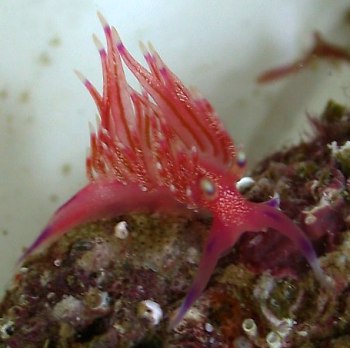
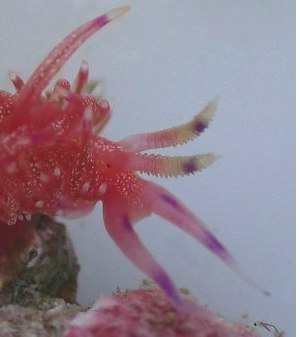
Flabellina cynara
(Marcus and Marcus, 1967)
Order: NUDIBRANCHIA
Suborder: AEOLIDINA
Family: Flabellinidae
DISTRIBUTION
Pacific coast of Central America
PHOTO
Playa Mismaloya (Bahia de Banderas), Mexico, 40 feet, 7mm long. Photos: Alicia Hermosillo
This species is commonly called the 'Swimming Cynara', and to quote Hans Bertsch:
"Most memorable is the swimming behavior of Flabellina cynara, which was so brilliantly illustrated by Wesley Farmer in his 1970 paper, "Swimming Gastropods (Opisthobranchia and Prosobranchia)" (The Veliger, 13: 80-83). The slug uses back-and-forth strokes of its whiplike cerata to propel itself through the water. The cerata gently curl forward in a loosely coordinated flowing movement, pause, and then whip backwards in a simultaneous power wave. The rearward flipping of the cerata is the propulsive stroke. Swimming up into the water column may allow the animal to hitch a ride on the water currents, aiding its escape from a predator or its search for prey or a mate".
Its body is deep pink with white spots. The long, thin cerata, are a translucent salmon-orange, with white speckling. They have a subterminal purple ring and a creamy white tip. The border of the foot has a rich purple marginal line. The translucent cephalic tentacles have a distal purple blotch. The the basal half of the lamellate rhinophores pinkish, and the upper half are creamy white with a subterminal purple band. Maximum body length between 40-50 mm.
See message #15281 for unspotted colour form.
-
Marcus, Er, & Marcus, Ev. (1967) American opisthobranch mollusks. Part 2, Opisthobranchs from the Gulf of California. Studies Tropical Oceanography, Miami, 6(1-2): 141-256. (Figs 1-95)
Hermosillo, A., 2002 (March 30) Flabellina cynara (Marcus and Marcus, 1967). [In] Sea Slug Forum. Australian Museum, Sydney. Available from http://www.seaslugforum.net/find/flabcyna
Related messages
Re: Flabellina cynara from Mexico
November 17, 2005
From: Alicia Hermosillo
Dear Bill and all,
The photo in Dave's message [#15281] is definitely Flabellina cynara.
They do some times come with spots, some times they do not, but just as you say, the shape of the body is so different between Bajaeolis bertschi and Flabellina cynara there is no doubt.
An interesting note. I have 6 species of Flabellina in the Puerto Vallarta area, 5 described, 1 undescribed. F. telja, F.vansyoci and Flabellina sp. nov. have white spots over somewhat pink-orange shade bodies.
Some specimens of F. marcusorum and F. cynara have white spots.
The only Flabellina without any spots whatsoever is F. bertschi.
Alicia Hermosillo
gueri25@hotmail.com
Hermosillo, A., 2005 (Nov 17) Re: Flabellina cynara from Mexico. [Message in] Sea Slug Forum. Australian Museum, Sydney. Available from http://www.seaslugforum.net/find/15291Thanks Ali,
Bill Rudman
Re: Flabellina cynara from Peru
November 16, 2005
From: Dave Behrens

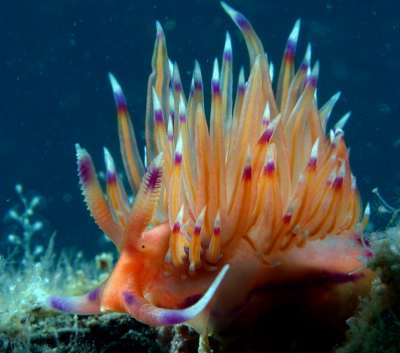
Hi Bill:
Concerning message #15249: Katia sent this me also and I ID'd it as Bajaeolis bertschi (see Camacho-Garcia, Gosliner and Valdes, 2005). Externally B. bertschi is close to Flabellina cynara. I am attaching 2 photos (from Behrens and Hermosillo (in press)), one of each species. Both by Alicia Hermosillo, both Puerto Vallarta.
Upper Photo: Bajaeolis bertschi
Lower Photo: Flabellina cynara
Locality: Puerto Vallarta, Mexico. Photographer: Alicia Hermosillo
Dave Behrens
dave@seachallengers.com
Behrens, D., 2005 (Nov 16) Re: Flabellina cynara from Peru. [Message in] Sea Slug Forum. Australian Museum, Sydney. Available from http://www.seaslugforum.net/find/15257Dear Dave (& Ali),
Thanks for the photos. I wondered about B. bertschi but plumped from F. cynara - mainly after looking at Ali's photos on the Forum which have the same white spots [message #6561]. The photo in your message above, of F. cynara shows no white spots but the same shaped animal as Ali's Forum photo. Can you confirm Ali's identification of F. cynara on the Forum? Certainly the long cerata held vertically, fit the image of this species being a swimming aeolid.
Best wishes,
Bill Rudman
Re Flabellina cynara & B. bertschi
November 16, 2005
From: Dave Behrens

Hi Bill:
Concerning your question in message #15257. I always had a problem with that photo [#6561] of Flabellina cynara. It has the ceratal core of F. cynara, but the spots of B. bertschi. Note the differences in the digestive gland diverticulum - in B. bertschi it is almost as thick as the ceras itself, while in F. cynara it is a thin tube. Not sure what to tell you = c.f. F. cynara, maybe?
Locality: Puerto Vallarta, Mexico. Photographer: Alicia Hermosillo
Wish I had seen these in person.
Dave Behrens
dave@seachallengers.com
Behrens, D., 2005 (Nov 16) Re Flabellina cynara & B. bertschi. [Message in] Sea Slug Forum. Australian Museum, Sydney. Available from http://www.seaslugforum.net/find/15281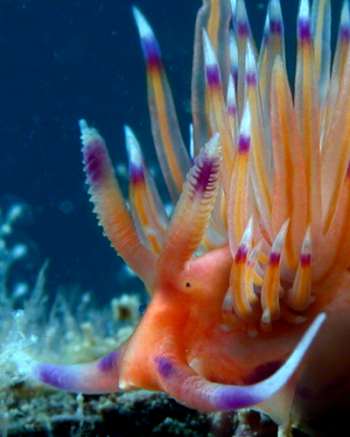
Dear Dave,
Certainly Ali's earlier photo and this one are identical in shape, with long vertically held cerata and thin digestive gland ducts in the cerata. They also both have elongate rhinophoral clubs with relatively short leaflets compared with 'typical' B. bertschi in which the rhinoophre clubs are shorter and fatter, and the leaflets are more numerous and closely packed together. Also they are white with a purple patch at the tip, while in this photo, and Ali's earlier one, the leaflet are not white and the purple forms a subterminal, not terminal, band. If they are the same species, I wonder why some parts of the population apparently mimic the colour pattern of B. bertschi.
Best wishes,
Bill Rudman
Flabellina cynara from Mexico
April 1, 2002
From: Alicia Hermosillo

Dear Dr. Rudman,
Here is some information and pictures on Flabellina cynara, a beautiful species we have over here.
The photos are of a 7 mm specimen collected 40 feet deep at Playa Mismaloya (Bahia de Banderas, Mexico), a place I call "Noche de la Iguana" because it is the location where a famous 1970s Elizabeth Taylor movie "The Night of the Iguana" was shot.
This species is commonly called the 'Swimming Cynara', and to quote Hans Bertsch:
"Most memorable is the swimming behavior of Flabellina cynara, which was so brilliantly illustrated by Wesley Farmer in his 1970 paper, "Swimming Gastropods (Opisthobranchia and Prosobranchia)" (The Veliger, 13: 80-83). The slug uses back-and-forth strokes of its whiplike cerata to propel itself through the water. The cerata gently curl forward in a loosely coordinated flowing movement, pause, and then whip backwards in a simultaneous power wave. The rearward flipping of the cerata is the propulsive stroke. Swimming up into the water column may allow the animal to hitch a ride on the water currents, aiding its escape from a predator or its search for prey or a mate".
Its body is of deep pink with white spots and it has very long and thin, salmon-orange cerata with white speckling and a subterminal purple ring. The border of the foot has a rich purple marginal line. The translucent cephalic tentacles have a distal purple blotch. It grows to about 40-50 mm long. Before my present studies, this species was only known to the northern Gulf of California, Mexico (Puerto Penasco and Guaymas, Sonora, on mainland Mexico; and Bahia de los Angeles, Baja California). This range extension has not yet been published.
Alicia
alicia_titan@infosel.net.mx

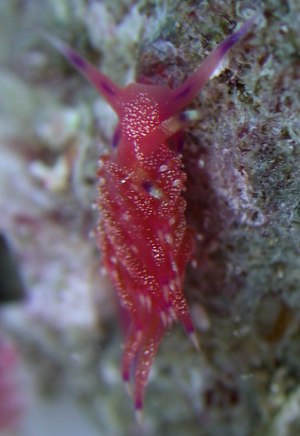
Dear Ali,
Thanks for sharing this beautiful animal.
Bill Rudman
